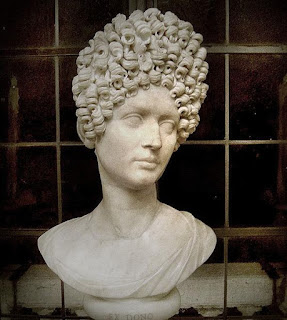Shining a Light on Ancient Greece
Είναι όλα Ελληνικά για ‘μένα. It’s
all Greek to me… Not something I imagined myself saying while on placement here
at The Roman Baths. Yet here I was, tasked with putting together a handling
session for my Tuesday Times Table and being drawn to my Greek heritage. Some
of the Greek pottery was brought to my attention, and it immediately peaked my
interest. I decided to bring out the Baths’ small collection of ancient Greek
oil lamps.
Hilariously (and embarrassingly), at first glance
and having only seen photographs of the top of the lamps, I thought they were
some form of ancient tea pots! With a bit of research into the collections
database, I was happily surprised to discover they were oil lamps, or lihnaria (λυχνάρια, sin. λυχνάρι).
Thus, my session became all about how the Ancient Greeks used these tiny pieces
of pottery to illuminate their lives.
 |
| Tori with her Tuesday Times Table |
I picked four lamps
that could be handled, and had various replicas to show the difference between
styles of lamps and the difference between Roman and Greek lamps. All of the
Greek lamps that were displayed are mould made. The first two lamps are
anthropomorphic, and date possibly between late 3rd and late 2nd
century B.C. These two were the most interesting to me because they had
human-like faces.
 |
| Anthropomorphic lamps |
The next lamp is possibly from the 3rd- late 2nd
century B.C., and has two distinctive Corinthian heads on either side. The last
lamp has been a little bit trickier to date and understand, because it is
missing its nozzle. It seems that it comes from Athens, but it could possibly
be Roman dating from when the Romans invaded Greece.
 |
| Lamp with Corinthian Heads and Possibly Roman Lamp |
The way the lamps were used was to pour oil in the
centre hole, and then grab some material for the wick and place into the spout
until it touches the oil. Then it could be lit, and could stay lit for a few
hours. Through my research, I discovered that there were many types of lamps
and some lamps even had multiple spouts to provide more light. However, these
lamps used up a lot of oil and burned much faster.
Overall, this was a really fun experience and I am
really happy I got the chance to bring out these ancient Greek oil lamps. This
was an excellent way to bring out parts of the Baths’ collections for everyone
to see. I cannot wait to see what future Tuesday Times Tables are in store!
 |
| At the end of Tori’s table, people got to make their own lamp to take home! |
Tori
Placement Student




